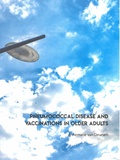Pneumococcal disease and vaccinations in older adults
Summary
Streptococcus pneumoniae is the most frequently detected human pathogen in respiratory infections with the highest incidence and burden in children, older adults, and the immunocompromised. Its polysaccharide-capsule has many structures creating nearly 100 different serotypes. The pneumococcus is involved in common respiratory tract infections such as sinusitis and otitis media as well as severe infections like community acquired pneumonia (CAP) and invasive pneumococcal disease (IPD). Pneumococcal disease is preceded by colonization. Humans and especially children are frequent nasopharyngeal carriers of S. pneumoniae without having any complaints. In June 2006, the 7-valent pneumococcal conjugate vaccine (PCV7), containing 7 capsular polysaccharides, was introduced into the Dutch National Immunization Program (NIP) for all infants. In March 2011, PCV7 was replaced by the 10-valent PHiD-CV10. PCVs induce anticapsular antibodies against the serotypes included in the vaccine. The first part of this thesis described the effect of PCVs in the NIP for infants on CAP and IPD incidence rates in the whole population. The introduction of PCV7 has led to a large decline in CAP and IPD hospitalizations caused by the 7 vaccine serotypes (VT) in children up to 2 years of age. Besides the direct individual protection against VT-disease, PCVs also reduce VT-carriage in vaccinated children. Since children are the key transmitters of pneumococcal strains in the population, the spread of VT in the population decreased, thereby indirectly protecting unvaccinated age-groups against VT-disease. While this resulted in a decline of VT-IPD especially in adults ≥ 65 years of age, this is not (yet) observed in CAP hospitalization rates. Moreover, the decrease in VT-IPD is partly counterbalanced by an increase in IPD by non-PCV-serotypes. Particularly older adults appear to be indifferent to the type of pneumococci. In children, the net benefit following PCV introduction is high, while in older adults it is limited by replacement disease. The second part of this thesis looks at the effect of the 13-valent PCV13 in immunocompetent community-dwelling adults aged ≥ 65 years naïve to pneumococcal vaccines within a randomized controlled trial. The cohort of 2,011 older adults was comprised of different age- and comorbidity-groups. PCV13 vaccination resulted in a temporary reduction of carriage of the 13 serotypes included in the vaccine 6 months post-vaccination, but this effect was no longer apparent after 12 months. In contrast to children, the decrease in carriage of PCV13-serotypes was not followed by a concomitant increase in carriage of non-PCV13-serotypes or changes in carriage of other common pathogens. Furthermore, PCV13 elicited serum opsonophagocytic activity titers and anti-capsular IgG levels that remained above baseline and the corresponding values in the placebo group for at least two years post-vaccination. These effects were regardless of age and self-reported comorbidities. This thesis showed that PCVs greatly impact pneumococcal disease in older adults. Herd protection after PCVs in infants is however progressively eroded by the continuous increase in NVT-disease. The solution to prevent pneumococcal disease in older adults, and in particular CAP, is difficult and still requires more research into many aspects of pneumococcal and lower respiratory tract infections.
